Coffee packaging can extend the freshness of coffee, it can be said that it directly affects the flavor of coffee. When customers hear a brand, they picture its packaging in their minds. Beautiful design is essential to coffee packaging, but roasters also need to consider the following six important aspects when choosing the best coffee packaging.
1. Coffee packaging style
Every company needs to differentiate itself from its competitors, and packaging is one of the easiest ways to do that. Therefore, your packaging needs to establish its own style and have a unique appeal. You can choose from different material or printing effect, with tin-tie, with one way coffee valves, and even unique print patterns. You can also focus on consumer convenience. And be creative, because the possibilities are endless.
The color of coffee packaging also has certain rules. According to the convention formed in the industry, the color of finished coffee packaging reflects the characteristics of coffee to a certain extent:
The coffee of red package, the taste is generally more massiness, can let drinker wake up quickly from last night’s good dream;
Black packaging coffee, belongs to the high quality small fruit coffee;
Gold packaging of coffee, a symbol of wealth, indicating that it is the best in coffee;
Coffee packaged in blue is usually “decaffeinated”.
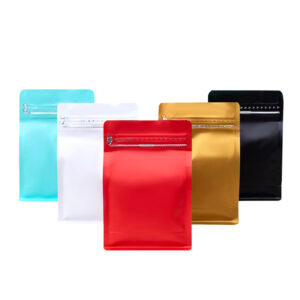
2. The shape of the coffee bag
There are four common types of coffee beans:
- Stand Up Pouch
The stand up bag is round at the bottom and flat at the top. No matter what kind of stand it is placed on, it can stand naturally and smoothly. Stand up bags are usually with zipper.
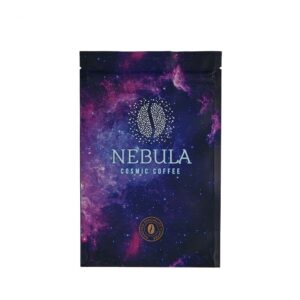
- The Side Gusset Bag
Side gusset bag is a more traditional packaging style, affordable and easy to use. The coffee beans can hold little more, the appearance of simple unique. Side gusset bags don’t stand as firmly, but they’re firmer. Side gusset bags, usually without seals, this bag type are folded down from the top of the bag and secured with labels or tin tie.
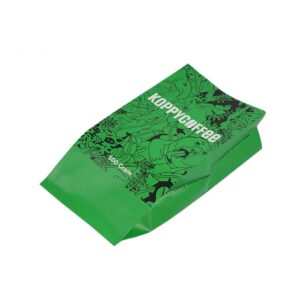
- Flat Bottom Bag
The square appearance of the flat bag makes it look like a box. It has a flat bottom, not only can stand smoothly, but also has a huge market. It is available in a variety of sizes with optional zipper seals. The American flat bottom bag is a little different from the European one in that the former is generally rolled up like a compact brick package, the latter is generally fitted with a sealing tin tie.
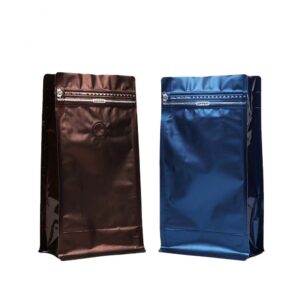
- Coffee powder usually comes in the form of small packets:
The strip packaging is convenient to tear, and it can be put into the cup quickly and easily. If the hot water is put in first there is more boost to get into the water. This is to facilitate pouring the ground coffee into the cup so that the powder does not easily fall out of the cup. In addition, the long cylindrical packaging bag is also easy to carry. Coffee packaging is generally designed to be convenient, eye-catching, and easy to store.

3. The barrier performance of coffee packaging bag
The coffee packaging bag needs to be sealed to ensure the freshness of the coffee. The sealing effect can be known by observing whether the packaging bag is installed with a one-way air intake valve. Coffee is very sensitive to external influences, so first you need to provide a barrier to the bag, which will help avoid interference from oxygen, UV rays and other factors. Many stand up coffee bags today have a three layer material with VMPET or AL.
Alternatively you can choose for a double layer high barrier polyester laminate, which guarantees the freshness of the coffee beans and is made of 100% plastic – including the one-way air valve and tin tie. These bags can be recycled and reused in most Nordic countries. To keep UV rays out of the bag as much as possible, consider black or white polyester or print a dense pattern.
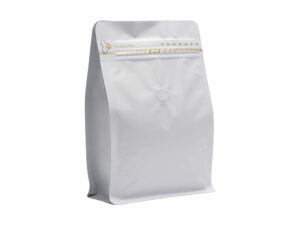
4. Coffee packaging process
Many roasters choose to pack their beans manually or semi-automatically, and the design of a coffee wrapper can be effective in speeding up or slowing down the process. If you choose to manually pack the stand up pouch, make sure the opening is wide enough to allow easy access to the beans. Also check that the bag is easy to open, easy to get the beans or put your hands in.
Box bags or The Square Seal Bag may have two corners and tin tie or four corners at the top but a side seal on the side, and need to be checked for confirmation before submission. In addition, if you are considering purchasing a fully automatic packing machine, be aware of the types of packaging the machine supports. Most machines support both types of packaging now.
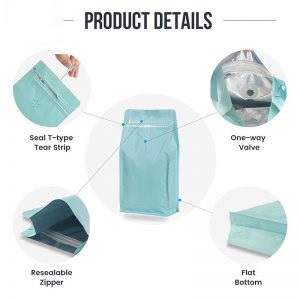
5. Sealing of coffee packaging bag
Generally, bagged coffee loses its original flavor soon after it is opened, but ziplock bags can keep the beans fresh. Users need to pay attention that when pulling the sealing ziplock, it is best to exhaust the air inside. The bag without the ziplock is suitable for small amounts of the same kind of things, which means it is more suitable for retail use or household use with low consumption. When choosing a ziplock bag, pay attention to the quality of the sealing zipper, so as to effectively ensure the freshness of the coffee and allow the user to use up every bean.
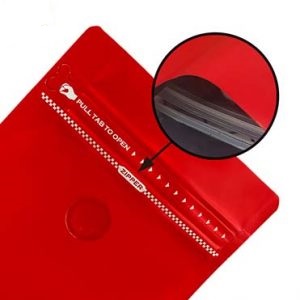
6. Labels for coffee bags
The specialty coffee industry loves its labels, and rightly so. You need a good label to show where the coffee came from, how it was treated, when it was roasted, and more about the beans. Don’t rush the design, this key element needs enough time to complete.
For commonly used packages, you may want a large, pre-printed logo and label. But for customized bags, small, clean labels can convey the coffee’s message, and the brand image can be better represented by the package design. Try to match the label material to the bag. Matt plastic or paper labels are suitable for matte surfaces. Shiny labels are better for glossy bags. Matt clear plastic tags are best for kraft paper bags.
Printing your own labels is cheaper and more flexible than sourcing ready-made labels. Buy a good label printer and make a template that fits your style and can easily change the details. If you want color labels, you can use pre-printed logos and artwork from vendors, as color cartridges are expensive for label printers. The colors and different fonts on the labels have a big impact on customers, and different colors and styles of fonts can be used to distinguish coffee bean information. Also make sure the label information is intuitive and consistent; if the description is unclear, the customer maybe choose another coffee bean on the shelf.

The choice of coffee packaging may seem like a very small part of roasting, but it has a significant impact on sales and the freshness of the coffee. Considering these six points will give you the confidence to make the right choice.
